There’s nothing easy about selecting the best VMS platform, with plenty of different solutions to choose from, each built around a different philosophy and with different network and operational requirements.
According to Mat Harrison of Network Optix, the key operational functionalities of the best VMS platform cover all areas of function, developer support, integration capability and ecosystem.
“A modern, well-designed VMS should be simple to install and require no prerequisite software (databases, .NET, etc), it should require no training to use at an advanced level (instantly usable), it should have a minimal set of required components (desktop, mobile, server, cloud), it should be a snap to maintain, upgrade, and expand, and it should be useful at any scale – from 1 to 100,000 cameras,” Harrison says.
“The system should automatically discover compatible hardware (e.g. IP cameras, I/O devices), should have open, free development tools to enable integration with any 3rd party solution and should have an open, free integrations ecosystem that lists integrated hardware and software solutions that integrators and end-users can use to add value to their VMS.”
When it comes to enterprise VMS, where recording, management and maintenance of the VMS are all vital, would Harrison agree things like centralised systems management, scalability, system health alerts, third party systems integration and a customisable user interface are increasingly important qualities?
“The ability to receive alerts, connect quickly to your VMS from anywhere, anytime, and have a central interface to connect to and manage all of your systems and/or sites is a no brainer and simply must exist in a modern VMS.” Harrison says.
“Health monitoring is also becoming a fundamental function of a modern VMS as it allows everyone in the chain to react quickly to any critical issues like hardware failure or software problems that may interrupt the normal flow of video and its related metadata.
“In terms of 3rd party systems integration – products that are proprietary are likely going to struggle. Interoperability and the ability to quickly integrate with a VMS should be a standard feature. It allows systems integrators – the real heroes of the security industry – to rapidly solve their customers’ individual problems and to also create real value by doing things that are unique to every customer and system.
“A customizable interface does the same thing; it enables systems integrators to work with their customers to create a system that is customer-tailored. In Nx Witness VMS, for example, customers are able to combine IP cameras, I/Os, and web-based applications into a single layout to create situational awareness for any usage scenario.”

Something that can be important with a hybrid solution operating partly in the cloud is bandwidth management and/or the ability to record at the edge. According to Harrison, there are a few things to consider when talking about hybrid vs direct-to-cloud IP video solutions – these include data, security, and reliability.
“In terms of data – high resolution, high frame rate IP cameras create huge amounts of data,” Harrison says. “In fact, they create so much data that it’s impossible to use the latest IP camera technology with a direct-to-cloud solution and maintain the integrity of the information being captured without massaging it in some way – reducing the frame rates, reducing the resolution, transcoding and compression, etc.
“A hybrid solution allows a VMS to capture the full spectrum of data being generated, ensuring nothing is lost, while simultaneously allowing customers to back up key / critical event or metadata-driven video to the cloud.
“In terms of security – on-prem video can effectively be firewalled and protected both digitally and physically. Steps can also be taken to secure cloud-based video, but a cloud solution is always going to be a black-box for users where they depend on the company providing the solution (who also depends on another company or companies to provide their infrastructure) to protect video. While it’s possible to provide secure cloud-based storage a hybrid model reduces potential vulnerabilities.
“When it comes to reliability, a hybrid solution will keep the video, in most cases, closer to the operators who are using it via a LAN/WAN connection. Less ISP routing = less latency = more reliability. Also, if a cloud-based solution goes down, there’s no way an integrator or end-user can address the issue. With a hybrid solution a system can be restarted on-site with some standard troubleshooting procedures.”
Harrison says the importance of some functionalities like graphics and mapping in a VMS depend on the application.
“It really depends on the customer and the use case,” he says. “More important would be the ability to generate custom experiences for customers based on their own needs. With Nx Witness, for example, customers can use our open REST HTTP API to create custom maps with mapping software like Google Maps, OpenStreetMaps, Mapbox, etc, and then open that in their interface with the embedded browser. A map is just another way of visualizing information. The key is a flexible desktop/interface and open developer tools.”
How important is integration when it comes to the latest VMS solutions, according to Harrison?
“Integration is extremely important,” he says. “Systems integrators integrate. A VMS should be able to integrate using standard tools HTTP requests (in/out) and with UI components like soft triggers that allow integrators to create instant, low-code integrations in minutes. And for more advanced integrations – like computer vision-based video analytics that detect objects and behaviours, the VMS should provide a standard plugin-based approach that allows integrators to create video solutions that capture real-world metadata for use not only in security surveillance applications but also for business intelligence.”
Licensing is another key area of decision making when it comes to VMS. While there can be gripes about per-camera licensing costs, there are upsides, too, including ongoing upgrades as solutions evolve.
“VMS manufacturers and integrators are going to have to work together to adapt to the changing landscape of software licensing and the movement away from project-based pricing (CAPEX) to service-based (OPEX) models,” argues Harrison. “If you really think about what integrators do – solve problems for their customers with technology – a recurring monthly or annual service fee makes a lot of sense and would allow systems integrators to reduce the up-front costs of installing a new system for their customers and allow them to forge longer-term, service-based relationships with customers.”
Video analytics is becoming an ever more central aspect of many specifications – how important is it that the best VMS offers functional video analytics modules with an operational focus, in Harrison’s opinion?
“A VMS should focus on those features which are universally desirable and useful,” he says. “There are definitely some video analytics which are considered universally useful at this point, but many of those capabilities are being adopted by camera manufacturers, as edge-based intelligence makes a lot of sense from a technology perspective. For instance, as streams are encoded, they are also analyzed. As a result, we don’t think baked-in analytics at the VMS level are a necessity and may, in fact, become detrimental to a VMS company’s ability to maintain a modern software package built on modern technologies.
“AI-driven analytics are also often dependent on specific computer hardware. At Nx, we felt it was a smart move to standardize how video analytics are integrated into our product. No matter what analytics package you are using, the base user experience is consistent. Our Plugin/Metadata SDK-based approach also gives systems integrators and end-users more flexibility when choosing analytics and allows them to change their analytics platform, if needed, with little to no pain and no need to learn a new software package.”
Anyone who has driven a modern VMS knows that there’s a huge amount of functionality in these systems and it can be difficult for interface designers to tuck it tidily away without it being hard to find. A key balancing act for decision makers as VMS becomes more complex is ensuring the user experience remains intuitive and seamless.
“The most important approach to keeping a VMS easy to use is to have a solid design foundation/language and to maintain that language as the product evolves,” Harrison explains. “This will allow users to grow with the software. Another important thing a VMS manufacturer can do to remain easy to use is to follow the trends of the software market as a whole and to design UX / UI in a way that users don’t need to learn how to use their software because they’ve already seen it before and are accustomed to the core mechanics.”
Over at Hills, Orlando Chiang says the key operational functionalities of the best VMS platforms include:
• Ease of navigation,
• User intuitive simple single click functions
• The inherent ability to notify the operators of any relevant issues or alerts with simply escalation and acknowledgement actions
• Provision of easy integration as an open platform without limiting functionality
• Focus the attention of the operator to relevant potential issues, removing the noise of information overload and operator distraction
• Provision of easy expandability with both forward and backward compatibility
• Provision of the ability to manage user rights at both macro and micro level
• The ability to take full advantage of AI to provide operators with more relevant information.
When it comes to hybrid solutions, Chiang says there are a number of issues to consider.
“With hybrid solutions becoming more popular, bandwidth requirements are an increasing concern, and have usually been mitigated by reducing the camera resolution up to the cloud,” he explains. “With uplinks and cloud storage costs becoming cheaper, eventually more systems will be hosted in the cloud, and at some point, with full resolution.
“With today’s cameras constantly increasing in resolution, bandwidth and storage requirements need to be taking into consideration when designing a cloud solution. As for edge recording, the issue has been the quality of the storage device, commonly an SD card. Most SD cards have a high read/write life these days but choosing the right one for constant duty is very important.”
Chiang agrees graphics and mapping are important to a quality VMS.
“With some operators needing to monitor 100s or 1000s of cameras, needing a simple interactive map or graphic display is vital to visualise the location and orientation of all the cameras. This becomes essential with operators actively tracking suspects in either live or playback scenarios.”
For Chiang, the subtleties of VMS integration can demand partnerships.
“Everyone can’t be good at everything – the same applies to VMS,” he explains. “Sometimes it’s good to stick to your strengths and bring in the experts for specialised functions. This is where easy integration comes in play and having an open platform makes this a lot easier.”

When it comes to licensing, Chiang says it pays for integrators to have an holistic, long-term view.
“Gone are the days when you could purchase a system and not touch it for the next 10 years,” he says. “These days software is constantly evolving, even replacing an obsolete camera could force a VMS system to be upgraded due to compatibility issues. Keeping a VMS system up to date with the latest software is an ongoing struggle for most system integrators and end users, as technology keeps advancing while camera manufactures and VMS system developers struggle to keep up and take advantage of the latest and greatest.
“Although there are gripes about licenses and maintenance plans, and the need to pay for them, it’s important to remember that someone needs to write new software and to evolve VMS technology. It is these licence and maintenance plans that keep that technology evolution moving forward. Without them advancement would stagnate.”
How important is it that the best VMS offers functional video analytics modules with an operational focus that can meet operational needs, in Chiang’s opinion?
“Video analytics has been the buzz word for a few years now and after reading a lot of specifications for major projects, video analytics has always seemed to be written into the specification as an afterthought,” says Chiang. “I have seen many specifications where analytics has been written in as a single line entry, indicating that the person writing the specification has very little knowledge of the complexity and the different aspects that need to be taken into consideration when designing an analytic solution.
“There are very few video analytics solutions that will provide high accuracy when analysing video in the wild. Most analytic engines require specific camera angles and pixels on target. Specifications need to be writing around the analytics and the problem the analytics are intended to solve. As for VMS systems that offer analytic engines or integration to analytic engines, the operational focus needs to be paramount. The operator should not have to know where one system end and where the other begins, the operation of the platforms should be seamless.
“At the same time, it’s very important that the VMS client platform is intuitive. A new operator, first day on the job, should be able to start operating the VMS client with little or no training. Of the VMS clients that I have worked on, only a few have achieved an intuitive platform, and even then, some functions took a while to work out. Achieving an intuitive client platform is very hard, as the way a platform is laid out might be logical for a software developer, but not for an end user. Some software companies spend millions on deciding on how to change a single icon to help improve the end user experience, however. VMS software developers don’t seem to be spending that much.”
Milestone’s Brett Hansen believes the key functionalities people look for in a VMS are based around the effectiveness of producing outcomes that the user is looking to achieve.
“These outcomes revolve around situational awareness to allow them to make accurate, efficient decisions,” Hansen says. “These outcomes can cover anything from typical surveillance requirements all the way up to beyond security approaches for business, health and safety as well as retail needs, to name a few.”
According to Hansen, recent events have highlighted how important VMS flexibility can be.
“We’ve seen how a year like 2020 can drastically change our environment,” he says. “To allow organisations to move with change and meet market demands, VMS needs to be agile and scalable. Allowance for adoption of new technology integrations is critical, as much as proactive system health and cyber protection.
“Hybrid VMS folds into scalability, particularly as it applies to operational effectiveness verses budget. On premises storage that allows for cloud archive and even more effective metadata cloud storage allows organisations to apply on demand analytics on historical data.”
For Hansen, graphics and mapping are vital to a quality VMS.
“Graphics and mapping speak to the effectiveness of situational awareness, allowing users and operators to make key decisions in a contextual method,” he explains. “You then allow for access and intrusion control into graphics and mapping as part of the integration requirement for VMS. I don’t believe the complexity of the VMS deployment needs to impact the user’s operational experience. While there may be challenges as a site scales, it’s vital the operator can make quick, well informed decisions.
“Obviously with VMS, integration is very important, as it promotes decision making options, such as command and control for a user/operator, from a single pane of glass. This type of integration speaks to efficiencies and leads to better, faster decision-making abilities.”

For Hansen, licensing and development are interrelated.
“Development is key to being scalable and agile, as well as being at the forefront of cyber security,” he says. “As previously mentioned with the importance of integration, 3rd party applications, devices and hardware constantly evolve, so maintaining a VMS application also ensures the ongoing functionality of the platform and the adoption of new features from these developing applications and devices.
“When it comes to video analytics, it’s important that the organisation’s outcomes are clearly understood so the analytic solution is applied effectively and is able to achieve the end user’s desired outcomes. If we keep this in mind, edge-based and/or server-based analytic solutions to key camera locations can deliver these outcomes and maintain budget.”
Andrew Cho of EOS says VMS needs to serve the main purpose of the software, which is managing video.
“The best VMS platform should make it easy to search, playback and retrieve the footage in the commonly available playable format,” Cho says. “The VMS should allow the operators to perform search, and playback at its fingertips without over complicating the process.”
When it comes to centralised systems management, scalability, system health alerts, third party systems integration and a customisable user interface Chos agrees these are important.
“I strongly agree when it comes to features like system health, customisable user interface,” he says. “Many organisations are now looking at centrally managing their video management platform at the head office level. They want to also keep an eye on security systems health to reduce the chance of the system failing or to minimise downtime during failures.”
Bandwidth management is the key success of the transition into cloud-based solutions, according to Cho.
“As we are still in the pre-mature stage of implementing a fully cloud-based solution, hybrid solutions require smart bandwidth management by recording at the edge and utilising the metadata to run smart searches,” he says. “Advancement of the accuracy of video analytics will also play a vital role, as it can reduce false alarms, which impact on use of bandwidth.”
When it comes to licensing gripes, Cho says a license-based solution is much more scalable in comparison to the non-licensed based system, such as an NVR or DVR, which are limited by hardware specifications.
“Instead, the CCTV solution evolves on a daily basis, and the end-user requirement needs to change along with it,” he explains. “If an organisation installed an appliance-based solution 2 years ago with a limitation of 5MP resolution, then the site cannot benefit from the latest multi-sensor or 4K fish-eye products to better manage the site. In contrast, the licensed-based VMS solution would have been the easy upgrade solution.”

How hard is it to ensure the user experience remains intuitive and seamless as VMS becomes more complex?
“As VMS technology develops, with an increasing greater demand for functionality, it is very difficult for systems to maintain the simplicity of the user interface,” Cho says. “It is important for the VMS developers to be mindful of the expansion. Also, sometimes updating the whole interface is required for some VMS solutions which have been adding features to the level they become nearly impossible to find.
“As part of VMS layout, graphics and mapping don’t always need to be overly impressive but must be simple and easy to use, and the features need to be neatly available. Because VMS is a video-centric platform that wants to achieve the outcome of proactive monitoring and better real-time response, integration is an integral part of this overall vision.
“Video analytics has become a vital part of managing video cleverly. The best VMS solution should offer video analytic modules to allows the end-users to utilise the available edge-based video analytic as well as server-based module, allowing the VMS to handle more complicated analytical tasks.”
How difficult is VMS to get right for integrators – why is training important – and how important is partnering with the right provider?
“Training on a VMS is essential for integrators,” Cho says. “However, before this training, selecting the right VMS and its distribution partner is also important. Offering a large selection of VMS options may sound good, but there are only a limited number of companies that can support them professionally.
“Once technicians do the training it’s important for them to maintain their knowledge by practising on a regular basis. This means the SI needs to have a sufficient number of projects using the VMS and the supplying partner must also have a wealth of knowledge and an assurance of continuity in support of the VMS.”
#sen.news











